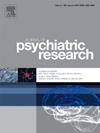Effect of bright light therapy on depression in patients with schizophrenia: A pilot study
IF 3.7
2区 医学
Q1 PSYCHIATRY
引用次数: 0
Abstract
Objective
In this pilot study, we investigated the effects of bright light therapy on depression in schizophrenia using a quasi-experimental design involving random assignment.
Methods
We included patients with schizophrenia who had stable psychiatric symptoms. Experimental group (n = 16) received light therapy while control group (n = 12) received only regular indoor light. The intervention was administered in the morning once a day for 50 min for three weeks. Scores of the Chinese version of the Calgary Depression Scale for Schizophrenia (CDSS-C), Chinese version of the Positive and Negative Syndrome Scale (PANSS-C), Clinical Global Impression-Schizophrenia Scale (CGI-SCH), and Stressful Life Event Scale (SLES) were measured at baseline (T0), immediately after 5th day of the intervention (T1), immediately after the 15th day of intervention (T2), and at the 14-day follow-up (T3). A generalized estimating equation (GEE) analysis was performed to analyse group × time interaction effects and effect of bright light therapy on depression.
Results
Results indicated that bright light therapy alleviated depressive symptoms in patients with schizophrenia after controlling for internal or surgical diseases and disease duration (in years). However, the effect was not maintained two weeks after the treatment.
Conclusion
These findings suggest that bright light therapy is a nonpharmacological adjunct treatment approach for patients with stable psychiatric symptoms.
求助全文
约1分钟内获得全文
求助全文
来源期刊

Journal of psychiatric research
医学-精神病学
CiteScore
7.30
自引率
2.10%
发文量
622
审稿时长
130 days
期刊介绍:
Founded in 1961 to report on the latest work in psychiatry and cognate disciplines, the Journal of Psychiatric Research is dedicated to innovative and timely studies of four important areas of research:
(1) clinical studies of all disciplines relating to psychiatric illness, as well as normal human behaviour, including biochemical, physiological, genetic, environmental, social, psychological and epidemiological factors;
(2) basic studies pertaining to psychiatry in such fields as neuropsychopharmacology, neuroendocrinology, electrophysiology, genetics, experimental psychology and epidemiology;
(3) the growing application of clinical laboratory techniques in psychiatry, including imagery and spectroscopy of the brain, molecular biology and computer sciences;
 求助内容:
求助内容: 应助结果提醒方式:
应助结果提醒方式:


